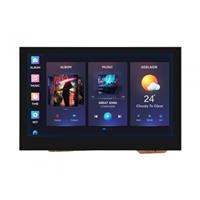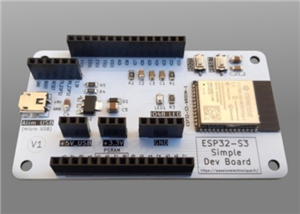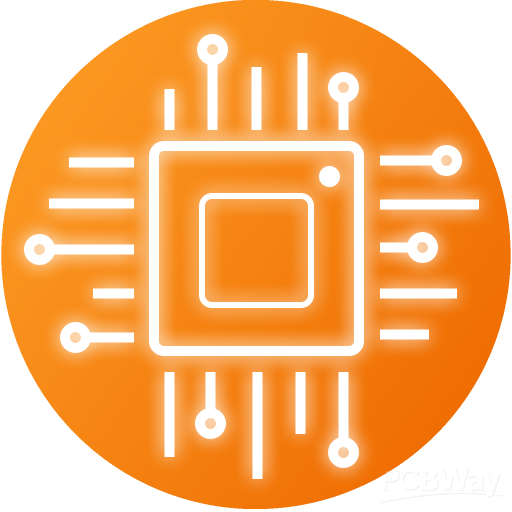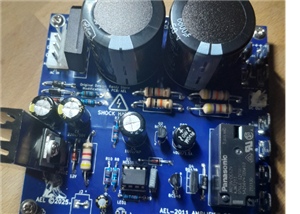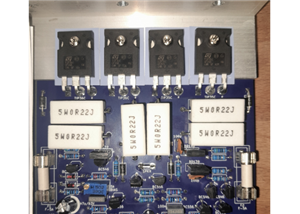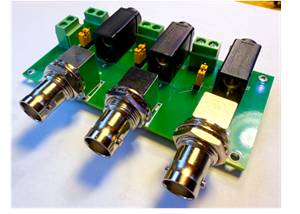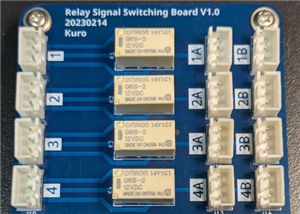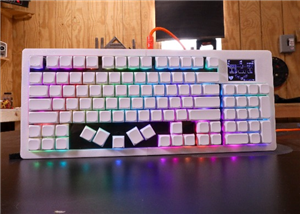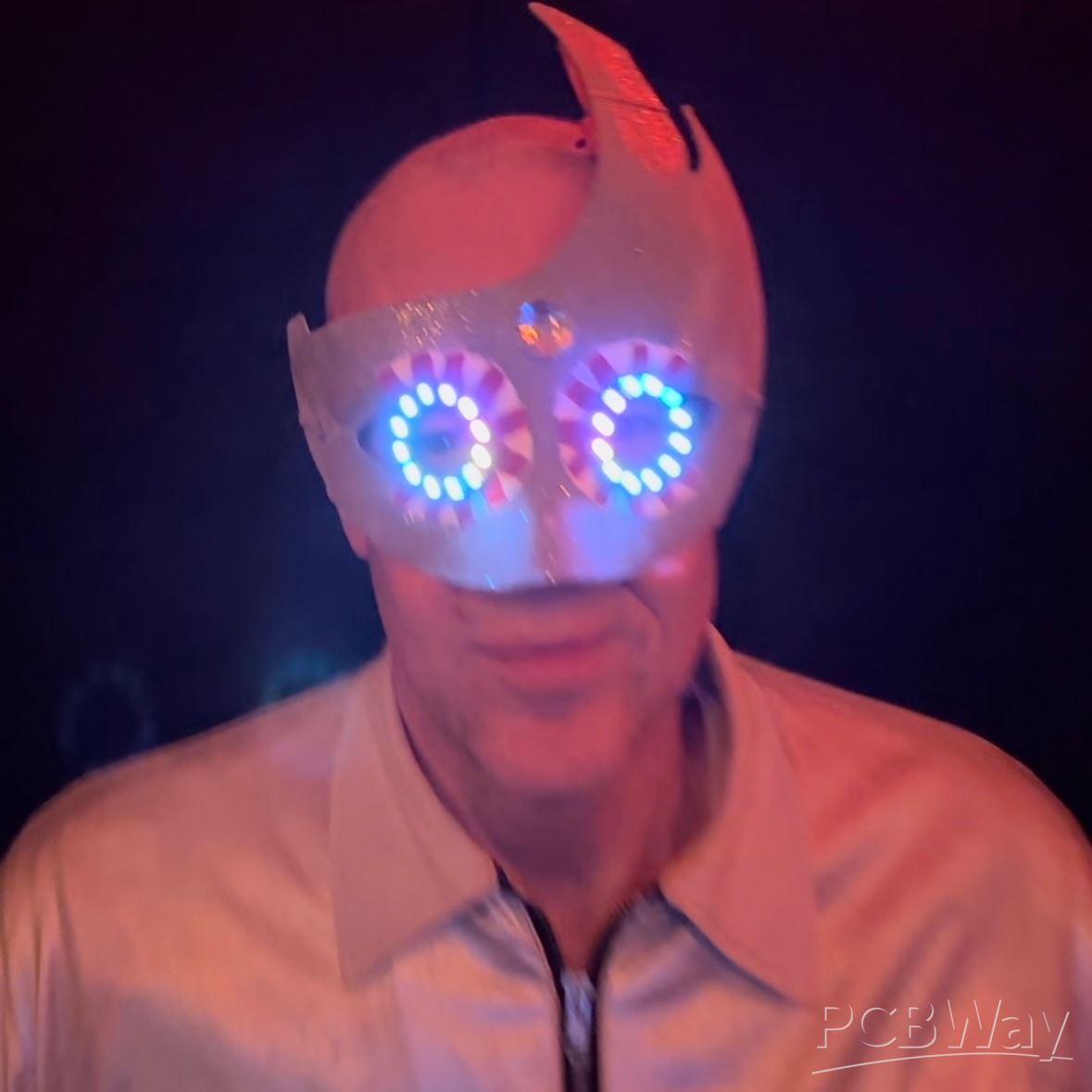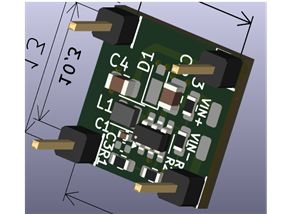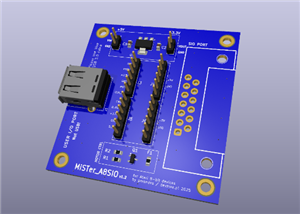|
|
ESP32 Development Board |
x 1 | |
|
|
6 DOF Sensor - MPU6050 |
x 1 | |
|
|
16x16 Led matrix with WS2812B chips |
x 1 | |
|
|
Button |
x 1 |

|
Soldering Iron Kit |
|

|
arduino IDEArduino
|
ESP32 Fluid simulation on 16x16 Led Matrix
Fluid simulation is a way of replicating the movement and behavior of liquids and gases in different environments. It’s widely used in fields like gaming, animation, engineering, and physics to create realistic visual effects and solve complex fluid-related problems.

This time I will present you a very simple way to make a fluid motion simulator using a few components. This is a simulator with a relatively low resolution of 256 dots and for that purpose a Display made of 16x16 LEDs with WS2812B LED chips is used.
Specifically, I am using a cheap ready-made module with 16x16 LEDs. However, on this small "Display" I will create some really cool visualizations.
The device is extremely simple to build and consists of only a few components.
- ESP32 Microcontroller Dev Board
- MPU6050 accelerometer module
- 16x16 Led module with WS2812B chips
- and Button

This project is sponsored by PCBWay. They has all the services you need to create your project at the best price, whether is a scool project, or complex professional project. On PCBWay you can share your experiences, or get inspiration for your next project. They also provide completed Surface mount SMT PCB assemblY service at a best price, and ISO9001 quality control. Visit pcbway.com for more services.

For this project I am using a box from one of my previous devices, for which I have also made a 3D printed grille for a better visual impression. Otherwise, even without this addition, the visual effect is impressive. It is important to note that the IMU sensor should be mounted in the way you see in the description, because otherwise you will get an undefined movement that does not comply with the laws of physics.

Now a few words about the software. The code is designed in a way that allows us to change multiple parameters, so we can simulate the movement of sand particles, liquids, gases, and other fluids.
First of all, we can change the number of active fluid particles and the light intensity of the LEDs. With the button, we can also choose one of the three colors for the LEDs that we have defined previously. At the beginning of the code, numerical values are given for some of the colors.

I will also present you a version of the code where the color of the particles changes dynamically depending on their location, which gives an even more interesting visual effect.
Then follow the basic physical quantities in the form of constants. By combining their values, various ways of moving fluids are obtained.

Now let's see how the device behaves in real conditions. I'll present you with just a few different situations, and you can experiment with many different combinations of physical constants.




And finally, a brief conclusion. This simple device serves only as a visual presentation of the way several different fluids move, i.e. primarily as a visually interesting toy for describing fluid dynamics.

#include <FastLED.h>
#include <Wire.h>
#include <MPU6050.h>
// Pin definitions
#define LED_PIN 5
#define SDA_PIN 21
#define SCL_PIN 22
#define NUM_LEDS 256
#define MATRIX_WIDTH 16
#define MATRIX_HEIGHT 16
#define FLUID_PARTICLES 64
#define BRIGHTNESS 100
// Structures
struct Vector2D {
float x;
float y;
};
struct Particle {
Vector2D position;
Vector2D velocity;
};
// Global variables
CRGB leds[NUM_LEDS];
MPU6050 mpu;
Particle particles[FLUID_PARTICLES];
Vector2D acceleration = {0, 0};
// Mutex for synchronization
portMUX_TYPE dataMux = portMUX_INITIALIZER_UNLOCKED;
// Adjusted constants for smoother motion
const float GRAVITY = 0.3f; //0.03f
const float DAMPING = 0.60f; // 0.98f
const float MAX_VELOCITY = 0.7f; //0.3f
const float MIN_MOVEMENT = 0.001f; //0.001f
// Function prototypes
void initMPU6050();
void initLEDs();
void initParticles();
void updateParticles();
void drawParticles();
void MPUTask(void *parameter);
void LEDTask(void *parameter);
// Function to convert x,y coordinates to LED index
int xy(int x, int y) {
x = constrain(x, 0, MATRIX_WIDTH - 1);
y = constrain(y, 0, MATRIX_HEIGHT - 1);
return (y & 1) ? (y * MATRIX_WIDTH + (MATRIX_WIDTH - 1 - x)) : (y * MATRIX_WIDTH + x);
}
void drawParticles() {
FastLED.clear();
// Create occupancy grid
bool occupied[MATRIX_WIDTH][MATRIX_HEIGHT] = {{false}};
// Get and smooth gravity direction
static Vector2D lastGravityDir = {0, 1};
Vector2D currentGravityDir;
portENTER_CRITICAL(&dataMux);
currentGravityDir = acceleration;
portEXIT_CRITICAL(&dataMux);
const float GRAVITY_SMOOTHING = 0.95f;
lastGravityDir.x = lastGravityDir.x * GRAVITY_SMOOTHING + currentGravityDir.x * (1 - GRAVITY_SMOOTHING);
lastGravityDir.y = lastGravityDir.y * GRAVITY_SMOOTHING + currentGravityDir.y * (1 - GRAVITY_SMOOTHING);
// Normalize gravity vector
float gravMagnitude = sqrt(lastGravityDir.x * lastGravityDir.x + lastGravityDir.y * lastGravityDir.y);
Vector2D gravityDir = {0, 1}; // Default down direction
if (gravMagnitude > 0.1f) {
gravityDir.x = lastGravityDir.x / gravMagnitude;
gravityDir.y = lastGravityDir.y / gravMagnitude;
}
// Calculate heights and prepare for drawing
float heights[FLUID_PARTICLES];
float minHeight = 1000;
float maxHeight = -1000;
for (int i = 0; i < FLUID_PARTICLES; i++) {
heights[i] = -(particles[i].position.x * gravityDir.x +
particles[i].position.y * gravityDir.y);
minHeight = min(minHeight, heights[i]);
maxHeight = max(maxHeight, heights[i]);
}
float heightRange = max(maxHeight - minHeight, 1.0f);
// Draw particles
int visibleCount = 0;
for (int i = 0; i < FLUID_PARTICLES; i++) {
int x = round(constrain(particles[i].position.x, 0, MATRIX_WIDTH - 1));
int y = round(constrain(particles[i].position.y, 0, MATRIX_HEIGHT - 1));
if (!occupied[x][y]) {
int index = xy(x, y);
if (index >= 0 && index < NUM_LEDS) {
float relativeHeight = (heights[i] - minHeight) / heightRange;
uint8_t hue = relativeHeight * 160; // Map from 0 (red) to 160 (blue)
uint8_t sat = 255; // Full saturation for vibrant colors
uint8_t val = 220 + (relativeHeight * 35); // Slightly brighter at top;
leds[index] = CHSV(hue, sat, val);
occupied[x][y] = true;
visibleCount++;
}
} else {
// Find nearest empty position
for (int dx = -1; dx <= 1; dx++) {
for (int dy = -1; dy <= 1; dy++) {
if (dx == 0 && dy == 0) continue;
int newX = x + dx;
int newY = y + dy;
if (newX >= 0 && newX < MATRIX_WIDTH &&
newY >= 0 && newY < MATRIX_HEIGHT &&
!occupied[newX][newY]) {
int index = xy(newX, newY);
if (index >= 0 && index < NUM_LEDS) {
float relativeHeight = (heights[i] - minHeight) / heightRange;
uint8_t hue = relativeHeight * 160; // Map from 0 (red) to 160 (blue)
uint8_t sat = 255; // Full saturation for vibrant colors
uint8_t val = 220 + (relativeHeight * 35); // Slightly brighter at top
leds[index] = CHSV(hue, sat, val);
occupied[newX][newY] = true;
visibleCount++;
goto particleDrawn;
}
}
}
}
particleDrawn: continue;
}
}
// Debug output
static unsigned long lastDebugTime = 0;
if (millis() - lastDebugTime > 1000) {
Serial.printf("Visible particles: %d of %d\n", visibleCount, FLUID_PARTICLES);
lastDebugTime = millis();
}
FastLED.show();
}
void updateParticles() {
Vector2D currentAccel;
portENTER_CRITICAL(&dataMux);
currentAccel = acceleration;
portEXIT_CRITICAL(&dataMux);
// Reduce acceleration sensitivity
currentAccel.x *= 0.3f;
currentAccel.y *= 0.3f;
// Update and constrain each particle
for (int i = 0; i < FLUID_PARTICLES; i++) {
// Update velocity with acceleration
particles[i].velocity.x = particles[i].velocity.x * 0.95f + (currentAccel.x * GRAVITY);
particles[i].velocity.y = particles[i].velocity.y * 0.95f + (currentAccel.y * GRAVITY);
// Hard constrain velocity
particles[i].velocity.x = constrain(particles[i].velocity.x, -MAX_VELOCITY, MAX_VELOCITY);
particles[i].velocity.y = constrain(particles[i].velocity.y, -MAX_VELOCITY, MAX_VELOCITY);
// Calculate new position
float newX = particles[i].position.x + particles[i].velocity.x;
float newY = particles[i].position.y + particles[i].velocity.y;
// Strict boundary checking with bounce
if (newX < 0.0f) {
newX = 0.0f;
particles[i].velocity.x = fabs(particles[i].velocity.x) * DAMPING;
}
else if (newX >= (MATRIX_WIDTH - 1.0f)) {
newX = MATRIX_WIDTH - 1.0f;
particles[i].velocity.x = -fabs(particles[i].velocity.x) * DAMPING;
}
if (newY < 0.0f) {
newY = 0.0f;
particles[i].velocity.y = fabs(particles[i].velocity.y) * DAMPING;
}
else if (newY >= (MATRIX_HEIGHT - 1.0f)) {
newY = MATRIX_HEIGHT - 1.0f;
particles[i].velocity.y = -fabs(particles[i].velocity.y) * DAMPING;
}
// Ensure positions are always within bounds
particles[i].position.x = constrain(newX, 0.0f, MATRIX_WIDTH - 1.0f);
particles[i].position.y = constrain(newY, 0.0f, MATRIX_HEIGHT - 1.0f);
// Additional safety check
if (isnan(particles[i].position.x) || isnan(particles[i].position.y)) {
particles[i].position.x = MATRIX_WIDTH / 2;
particles[i].position.y = MATRIX_HEIGHT / 2;
particles[i].velocity.x = 0;
particles[i].velocity.y = 0;
}
}
// Particle collision detection and resolution
for (int i = 0; i < FLUID_PARTICLES; i++) {
for (int j = i + 1; j < FLUID_PARTICLES; j++) {
float dx = particles[j].position.x - particles[i].position.x;
float dy = particles[j].position.y - particles[i].position.y;
float distSquared = dx * dx + dy * dy;
if (distSquared < 1.0f && distSquared > 0.0f) {
float dist = sqrt(distSquared);
float nx = dx / dist;
float ny = dy / dist;
// Push particles apart
float pushDistance = (1.0f - dist) * 0.5f;
float pushX = nx * pushDistance;
float pushY = ny * pushDistance;
// Update positions while ensuring they stay in bounds
particles[i].position.x = constrain(particles[i].position.x - pushX, 0.0f, MATRIX_WIDTH - 1.0f);
particles[i].position.y = constrain(particles[i].position.y - pushY, 0.0f, MATRIX_HEIGHT - 1.0f);
particles[j].position.x = constrain(particles[j].position.x + pushX, 0.0f, MATRIX_WIDTH - 1.0f);
particles[j].position.y = constrain(particles[j].position.y + pushY, 0.0f, MATRIX_HEIGHT - 1.0f);
// Exchange velocities with damping
float tempVelX = particles[i].velocity.x;
float tempVelY = particles[i].velocity.y;
particles[i].velocity.x = particles[j].velocity.x * DAMPING;
particles[i].velocity.y = particles[j].velocity.y * DAMPING;
particles[j].velocity.x = tempVelX * DAMPING;
particles[j].velocity.y = tempVelY * DAMPING;
}
}
}
}
void initMPU6050() {
Serial.println("Initializing MPU6050...");
mpu.initialize();
if (!mpu.testConnection()) {
Serial.println("MPU6050 connection failed!");
while (1) {
delay(100);
}
}
mpu.setFullScaleAccelRange(MPU6050_ACCEL_FS_2);
Serial.println("MPU6050 initialized");
}
void initLEDs() {
Serial.println("Initializing LEDs...");
FastLED.addLeds<WS2812B, LED_PIN, GRB>(leds, NUM_LEDS);
FastLED.setBrightness(BRIGHTNESS);
FastLED.clear(true);
Serial.println("LEDs initialized");
}
void initParticles() {
Serial.println("Initializing particles...");
int index = 0;
for (int y = MATRIX_HEIGHT - 4; y < MATRIX_HEIGHT; y++) {
for (int x = 0; x < MATRIX_WIDTH && index < FLUID_PARTICLES; x++) {
Serial.printf("Initializing particle %d at x=%d, y=%d\n", index, x, y);
particles[index].position = {static_cast<float>(x), static_cast<float>(y)};
particles[index].velocity = {0.0f, 0.0f};
index++;
}
}
Serial.printf("Total particles initialized: %d\n", index);
Serial.println("Particles initialized");
}
void MPUTask(void *parameter) {
while (true) {
int16_t ax, ay, az;
mpu.getAcceleration(&ax, &ay, &az);
portENTER_CRITICAL(&dataMux);
acceleration.x = -constrain(ax / 16384.0f, -1.0f, 1.0f);
acceleration.y = constrain(ay / 16384.0f, -1.0f, 1.0f);
portEXIT_CRITICAL(&dataMux);
vTaskDelay(pdMS_TO_TICKS(10));
}
}
void LEDTask(void *parameter) {
TickType_t xLastWakeTime = xTaskGetTickCount();
const TickType_t xFrequency = pdMS_TO_TICKS(16);
while (true) {
updateParticles();
drawParticles();
vTaskDelayUntil(&xLastWakeTime, xFrequency);
}
}
void setup() {
Serial.begin(115200);
delay(1000);
Serial.println("Starting initialization...");
Wire.begin(SDA_PIN, SCL_PIN);
Wire.setClock(400000);
initMPU6050();
initLEDs();
initParticles();
xTaskCreatePinnedToCore(
MPUTask,
"MPUTask",
4096,
NULL,
2,
NULL,
0
);
xTaskCreatePinnedToCore(
LEDTask,
"LEDTask",
4096,
NULL,
1,
NULL,
1
);
Serial.println("Setup complete");
}
void loop() {
vTaskDelete(NULL);
}
// colors: 0 = Red, 32 = Orange, 64 = Yellow, 96 = Green, 128 = Aqua, 160 = Blue, 192 = Purple, 224 = Pink
#include <FastLED.h>
#include <Wire.h>
#include <MPU6050.h>
// Pin definitions
#define LED_PIN 5
#define SDA_PIN 21
#define SCL_PIN 22
#define BUTTON_PIN 4 // Button for color switching
#define NUM_LEDS 256
#define MATRIX_WIDTH 16
#define MATRIX_HEIGHT 16
#define FLUID_PARTICLES 64 //80/64
#define BRIGHTNESS 30
#define NUM_COLORS 3 // Number of color options
// Structures
struct Vector2D {
float x;
float y;
};
struct Particle {
Vector2D position;
Vector2D velocity;
};
// Global variables
CRGB leds[NUM_LEDS];
MPU6050 mpu;
Particle particles[FLUID_PARTICLES];
Vector2D acceleration = {0, 0};
// Color switching variables
uint8_t currentColorIndex = 0;
unsigned long lastDebounceTime = 0;
const unsigned long debounceDelay = 200;
// Define the colors (you can change these hue values)
const uint8_t COLORS[NUM_COLORS] = {
160, // Blue
0, // Red
96 // Green
};
// Mutex for synchronization
portMUX_TYPE dataMux = portMUX_INITIALIZER_UNLOCKED;
// Constants for physics
const float GRAVITY = 0.08f; //0.3f /098f
const float DAMPING = 0.92f; //0.99f /0.9f
const float MAX_VELOCITY = 0.6f; //0.6f /2.9f
// Function prototypes
void initMPU6050();
void initLEDs();
void initParticles();
void updateParticles();
void drawParticles();
void MPUTask(void *parameter);
void LEDTask(void *parameter);
void checkButton();
// Function to convert x,y coordinates to LED index
int xy(int x, int y) {
x = constrain(x, 0, MATRIX_WIDTH - 1);
y = constrain(y, 0, MATRIX_HEIGHT - 1);
return (y & 1) ? (y * MATRIX_WIDTH + (MATRIX_WIDTH - 1 - x)) : (y * MATRIX_WIDTH + x);
}
void checkButton() {
static bool lastButtonState = HIGH;
bool buttonState = digitalRead(BUTTON_PIN);
if (buttonState == LOW && lastButtonState == HIGH) { // Button pressed
if ((millis() - lastDebounceTime) > debounceDelay) {
currentColorIndex = (currentColorIndex + 1) % NUM_COLORS;
lastDebounceTime = millis();
}
}
lastButtonState = buttonState;
}
void drawParticles() {
FastLED.clear();
bool occupied[MATRIX_WIDTH][MATRIX_HEIGHT] = {{false}};
struct ParticleIndex {
int index;
float position;
};
ParticleIndex sortedParticles[FLUID_PARTICLES];
for (int i = 0; i < FLUID_PARTICLES; i++) {
sortedParticles[i].index = i;
sortedParticles[i].position = particles[i].position.y * MATRIX_WIDTH + particles[i].position.x;
}
for (int i = 0; i < FLUID_PARTICLES - 1; i++) {
for (int j = 0; j < FLUID_PARTICLES - i - 1; j++) {
if (sortedParticles[j].position > sortedParticles[j + 1].position) {
ParticleIndex temp = sortedParticles[j];
sortedParticles[j] = sortedParticles[j + 1];
sortedParticles[j + 1] = temp;
}
}
}
for (int i = 0; i < FLUID_PARTICLES; i++) {
int particleIndex = sortedParticles[i].index;
int x = round(particles[particleIndex].position.x);
int y = round(particles[particleIndex].position.y);
x = constrain(x, 0, MATRIX_WIDTH - 1);
y = constrain(y, 0, MATRIX_HEIGHT - 1);
if (!occupied[x][y]) {
int index = xy(x, y);
if (index >= 0 && index < NUM_LEDS) {
float speed = sqrt(
particles[particleIndex].velocity.x * particles[particleIndex].velocity.x +
particles[particleIndex].velocity.y * particles[particleIndex].velocity.y
);
uint8_t hue = COLORS[currentColorIndex];
uint8_t sat = 255;
uint8_t val = constrain(180 + (speed * 50), 180, 255);
leds[index] = CHSV(hue, sat, val);
occupied[x][y] = true;
}
} else {
for (int r = 1; r < 3; r++) {
for (int dx = -r; dx <= r; dx++) {
for (int dy = -r; dy <= r; dy++) {
if (abs(dx) + abs(dy) == r) {
int newX = x + dx;
int newY = y + dy;
if (newX >= 0 && newX < MATRIX_WIDTH &&
newY >= 0 && newY < MATRIX_HEIGHT &&
!occupied[newX][newY]) {
int index = xy(newX, newY);
if (index >= 0 && index < NUM_LEDS) {
leds[index] = CHSV(COLORS[currentColorIndex], 255, 180);
occupied[newX][newY] = true;
goto nextParticle;
}
}
}
}
}
}
nextParticle:
continue;
}
}
FastLED.show();
}
void updateParticles() {
Vector2D currentAccel;
portENTER_CRITICAL(&dataMux);
currentAccel = acceleration;
portEXIT_CRITICAL(&dataMux);
currentAccel.x *= 0.3f;
currentAccel.y *= 0.3f;
for (int i = 0; i < FLUID_PARTICLES; i++) {
particles[i].velocity.x = particles[i].velocity.x * 0.9f + (currentAccel.x * GRAVITY);
particles[i].velocity.y = particles[i].velocity.y * 0.9f + (currentAccel.y * GRAVITY);
particles[i].velocity.x = constrain(particles[i].velocity.x, -MAX_VELOCITY, MAX_VELOCITY);
particles[i].velocity.y = constrain(particles[i].velocity.y, -MAX_VELOCITY, MAX_VELOCITY);
float newX = particles[i].position.x + particles[i].velocity.x;
float newY = particles[i].position.y + particles[i].velocity.y;
if (newX < 0.0f) {
newX = 0.0f;
particles[i].velocity.x = fabs(particles[i].velocity.x) * DAMPING;
}
else if (newX >= (MATRIX_WIDTH - 1)) {
newX = MATRIX_WIDTH - 1;
particles[i].velocity.x = -fabs(particles[i].velocity.x) * DAMPING;
}
if (newY < 0.0f) {
newY = 0.0f;
particles[i].velocity.y = fabs(particles[i].velocity.y) * DAMPING;
}
else if (newY >= (MATRIX_HEIGHT - 1)) {
newY = MATRIX_HEIGHT - 1;
particles[i].velocity.y = -fabs(particles[i].velocity.y) * DAMPING;
}
particles[i].position.x = constrain(newX, 0.0f, MATRIX_WIDTH - 1);
particles[i].position.y = constrain(newY, 0.0f, MATRIX_HEIGHT - 1);
particles[i].velocity.x *= 0.95f;
particles[i].velocity.y *= 0.95f;
}
for (int i = 0; i < FLUID_PARTICLES; i++) {
for (int j = i + 1; j < FLUID_PARTICLES; j++) {
float dx = particles[j].position.x - particles[i].position.x;
float dy = particles[j].position.y - particles[i].position.y;
float distanceSquared = dx * dx + dy * dy;
if (distanceSquared < 1.0f) {
float distance = sqrt(distanceSquared);
float angle = atan2(dy, dx);
float repulsionX = cos(angle) * 0.5f;
float repulsionY = sin(angle) * 0.5f;
particles[i].position.x -= repulsionX * 0.3f;
particles[i].position.y -= repulsionY * 0.3f;
particles[j].position.x += repulsionX * 0.3f;
particles[j].position.y += repulsionY * 0.3f;
Vector2D avgVel = {
(particles[i].velocity.x + particles[j].velocity.x) * 0.5f,
(particles[i].velocity.y + particles[j].velocity.y) * 0.5f
};
particles[i].velocity = avgVel;
particles[j].velocity = avgVel;
}
}
}
}
void initMPU6050() {
Serial.println("Initializing MPU6050...");
mpu.initialize();
if (!mpu.testConnection()) {
Serial.println("MPU6050 connection failed!");
while (1) {
delay(100);
}
}
mpu.setFullScaleAccelRange(MPU6050_ACCEL_FS_2);
Serial.println("MPU6050 initialized");
}
void initLEDs() {
Serial.println("Initializing LEDs...");
FastLED.addLeds<WS2812B, LED_PIN, GRB>(leds, NUM_LEDS);
FastLED.setBrightness(BRIGHTNESS);
FastLED.clear(true);
Serial.println("LEDs initialized");
}
void initParticles() {
Serial.println("Initializing particles...");
int index = 0;
for (int y = MATRIX_HEIGHT - 4; y < MATRIX_HEIGHT; y++) {
for (int x = 0; x < MATRIX_WIDTH && index < FLUID_PARTICLES; x++) {
particles[index].position = {static_cast<float>(x), static_cast<float>(y)};
particles[index].velocity = {0.0f, 0.0f};
index++;
}
}
Serial.printf("Total particles initialized: %d\n", index);
}
void MPUTask(void *parameter) {
while (true) {
int16_t ax, ay, az;
mpu.getAcceleration(&ax, &ay, &az);
portENTER_CRITICAL(&dataMux);
acceleration.x = -constrain(ax / 16384.0f, -1.0f, 1.0f);
acceleration.y = constrain(ay / 16384.0f, -1.0f, 1.0f);
portEXIT_CRITICAL(&dataMux);
vTaskDelay(pdMS_TO_TICKS(10));
}
}
void LEDTask(void *parameter) {
TickType_t xLastWakeTime = xTaskGetTickCount();
const TickType_t xFrequency = pdMS_TO_TICKS(16);
while (true) {
checkButton();
updateParticles();
drawParticles();
vTaskDelayUntil(&xLastWakeTime, xFrequency);
}
}
void setup() {
Serial.begin(115200);
delay(1000);
Serial.println("Starting initialization...");
// Initialize button pin
pinMode(BUTTON_PIN, INPUT_PULLUP);
Wire.begin(SDA_PIN, SCL_PIN);
Wire.setClock(400000);
initMPU6050();
initLEDs();
initParticles();
xTaskCreatePinnedToCore(
MPUTask,
"MPUTask",
4096,
NULL,
2,
NULL,
0
);
xTaskCreatePinnedToCore(
LEDTask,
"LEDTask",
4096,
NULL,
1,
NULL,
1
);
Serial.println("Setup complete");
}
void loop() {
vTaskDelete(NULL);
}
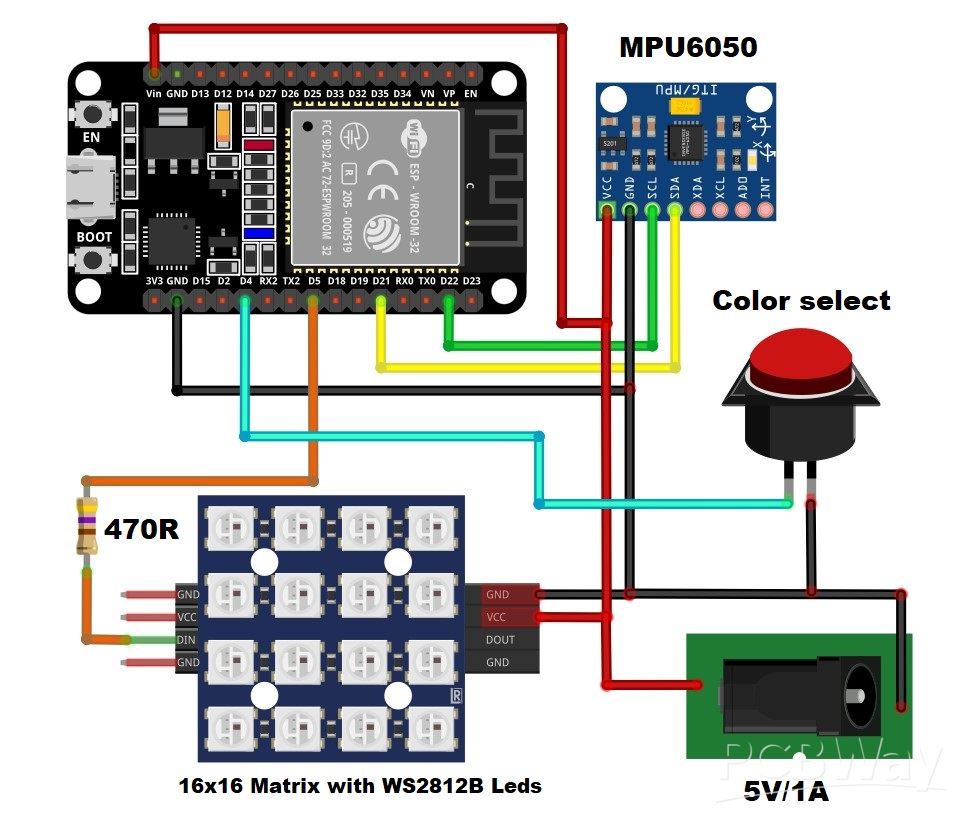
ESP32 Fluid simulation on 16x16 Led Matrix
- Comments(0)
- Likes(0)
- 0 USER VOTES
- YOUR VOTE 0.00 0.00
- 1
- 2
- 3
- 4
- 5
- 6
- 7
- 8
- 9
- 10
- 1
- 2
- 3
- 4
- 5
- 6
- 7
- 8
- 9
- 10
- 1
- 2
- 3
- 4
- 5
- 6
- 7
- 8
- 9
- 10
- 1
- 2
- 3
- 4
- 5
- 6
- 7
- 8
- 9
- 10
 More by Mirko Pavleski
More by Mirko Pavleski
-
 Arduino 3D Printed self Balancing Cube
Self-balancing devices are electronic devices that use sensors and motors to keep themselves balanc...
Arduino 3D Printed self Balancing Cube
Self-balancing devices are electronic devices that use sensors and motors to keep themselves balanc...
-
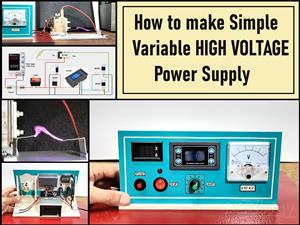 How to make simple Variable HIGH VOLTAGE Power Supply
High Voltage Power Supply is usually understood as a device that is capable of generating a voltage...
How to make simple Variable HIGH VOLTAGE Power Supply
High Voltage Power Supply is usually understood as a device that is capable of generating a voltage...
-
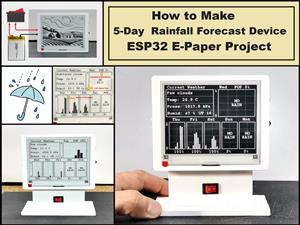 DIY 5-Day Rainfall Forecast Device - ESP32 E-Paper Project
In several of my previous projects I have presented ways to make weather stations, but this time I ...
DIY 5-Day Rainfall Forecast Device - ESP32 E-Paper Project
In several of my previous projects I have presented ways to make weather stations, but this time I ...
-
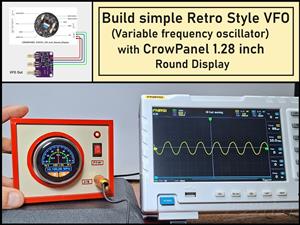 Build simple Retro Style VFO (Variable frequency oscillator) with Crowoanel 1.28 inch Round Display
Today I received a shipment with a Small round LCD display from Elecrow. The device is packed in tw...
Build simple Retro Style VFO (Variable frequency oscillator) with Crowoanel 1.28 inch Round Display
Today I received a shipment with a Small round LCD display from Elecrow. The device is packed in tw...
-
 Human vs Robot – Rock Paper Scissors with MyCobot 280 M5Stack
Today I received a package containing the few Elephant Robotics products. The shipment is well pack...
Human vs Robot – Rock Paper Scissors with MyCobot 280 M5Stack
Today I received a package containing the few Elephant Robotics products. The shipment is well pack...
-
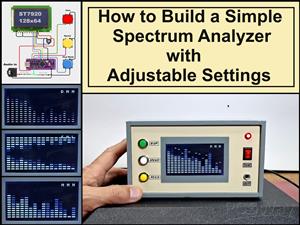 How to Build a Simple Audio Spectrum Analyzer with Adjustable Settings
An audio spectrum analyzer is an electronic device or software tool that measures and visually disp...
How to Build a Simple Audio Spectrum Analyzer with Adjustable Settings
An audio spectrum analyzer is an electronic device or software tool that measures and visually disp...
-
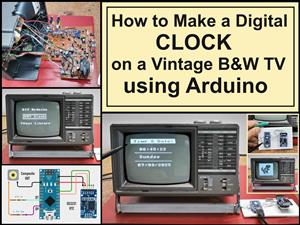 How to Make a Digital Clock on a Vintage B&W TV using Arduino
These days I accidentally came across this small retro Black and White TV with a built-in Radio, so ...
How to Make a Digital Clock on a Vintage B&W TV using Arduino
These days I accidentally came across this small retro Black and White TV with a built-in Radio, so ...
-
 Build a $10 Function Generator with Frequency Meter for Your Lab
A function generator is a piece of electronic test equipment used to generate various types of elec...
Build a $10 Function Generator with Frequency Meter for Your Lab
A function generator is a piece of electronic test equipment used to generate various types of elec...
-
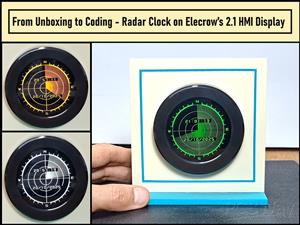 From Unboxing to Coding - Radar Clock on Elecrow’s 2.1 HMI Display
Today I received a shipment with a large round LCD display from Elecrow. The device is packed in two...
From Unboxing to Coding - Radar Clock on Elecrow’s 2.1 HMI Display
Today I received a shipment with a large round LCD display from Elecrow. The device is packed in two...
-
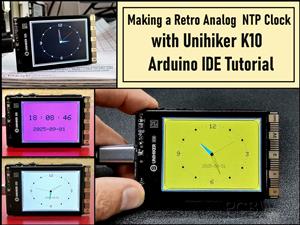 Making a Retro Analog NTP Clock with Unihiker K10 - Arduino IDE Tutorial
Some time ago I presented you a way to use standard Arduino libraries on the Unihiker k10 developme...
Making a Retro Analog NTP Clock with Unihiker K10 - Arduino IDE Tutorial
Some time ago I presented you a way to use standard Arduino libraries on the Unihiker k10 developme...
-
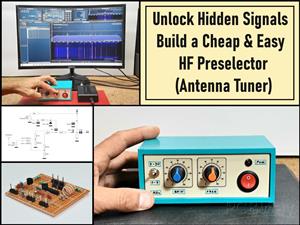 Build a Cheap & Easy HF Preselector - Antenna Tuner
HF antenna preselector is an electronic device connected between an HF radio antenna, and a radio r...
Build a Cheap & Easy HF Preselector - Antenna Tuner
HF antenna preselector is an electronic device connected between an HF radio antenna, and a radio r...
-
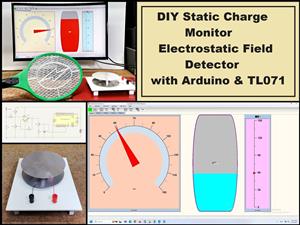 DIY Static Charge Monitor - Electrostatic Field Detector (Arduino & TL071)
A Static Charge Monitor also known as a Static Field Meter or Electrostatic Voltmeter is a device u...
DIY Static Charge Monitor - Electrostatic Field Detector (Arduino & TL071)
A Static Charge Monitor also known as a Static Field Meter or Electrostatic Voltmeter is a device u...
-
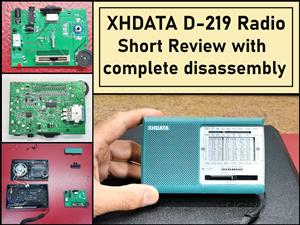 XHDATA D-219 Radio Short Review with complete disassembly
Some time ago I received an offer from XHDATA to be one of the first test users of their new radio m...
XHDATA D-219 Radio Short Review with complete disassembly
Some time ago I received an offer from XHDATA to be one of the first test users of their new radio m...
-
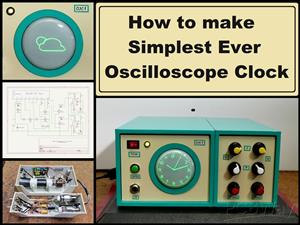 How to make Simplest ever Oscilloscope Clock
An oscilloscope clock is a unique and creative way to display the time using an oscilloscope, which...
How to make Simplest ever Oscilloscope Clock
An oscilloscope clock is a unique and creative way to display the time using an oscilloscope, which...
-
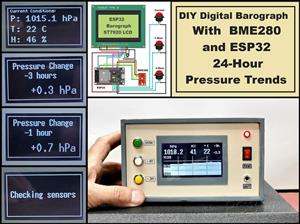 DIY Digital Barograph with BME280 and ESP32 - 24 Hour Pressure Trends
A barograph is a self-recording barometer that continuously measures and records atmospheric pressu...
DIY Digital Barograph with BME280 and ESP32 - 24 Hour Pressure Trends
A barograph is a self-recording barometer that continuously measures and records atmospheric pressu...
-
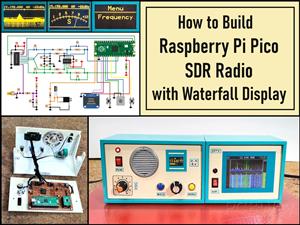 Build a Raspberry Pi Pico SDR Radio with Waterfall Display
Software-defined radio (SDR) is a radio communication system where components that have traditional...
Build a Raspberry Pi Pico SDR Radio with Waterfall Display
Software-defined radio (SDR) is a radio communication system where components that have traditional...
-
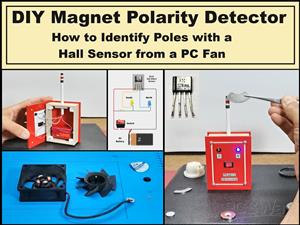 DIY Magnet Polarity Detector - How to Identify Poles with a Hall Sensor from a PC Fan
Recently, while working on a project, I needed to determine the polarity of several permanent magne...
DIY Magnet Polarity Detector - How to Identify Poles with a Hall Sensor from a PC Fan
Recently, while working on a project, I needed to determine the polarity of several permanent magne...
-
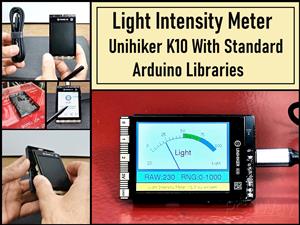 Light Meter Project - Making Dfrobot Unihiker K10 Work with Standard Arduino Libraries
The other day I received a shipment with a UNIHIKER K10 development board from DFRobot, which I rec...
Light Meter Project - Making Dfrobot Unihiker K10 Work with Standard Arduino Libraries
The other day I received a shipment with a UNIHIKER K10 development board from DFRobot, which I rec...
-
-
AEL-2011 Power Supply Module
545 0 2 -
AEL-2011 50W Power Amplifier
505 0 2 -
-
-
Custom Mechanical Keyboard
706 0 0 -
Tester for Touch Screen Digitizer without using microcontroller
337 2 2 -
Audio reactive glow LED wristband/bracelet with NFC / RFID-Tags
317 0 1 -
-
-


















